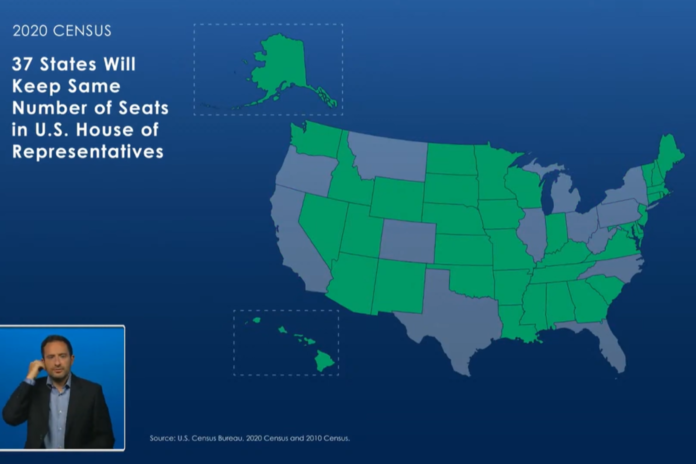
(Daily Caller News Foundation) — Texas and Florida are slated to gain congressional seats during the decennial redistricting process, while California and New York are set to each lose one, the U.S. Census Bureau announced Monday.
The U.S. Census Bureau released the decennial state population and congressional apportionment totals Monday, outlining how many districts each state will have for the next decade. The data also determines how many Electoral College votes each state will have through 2032, and allocates how federal money is distributed to each state for schools, roads and other public projects.
The release was originally scheduled for December, but faced delays due to the coronavirus pandemic and the Trump administration’s unsuccessful effort to exclude non-citizens from the count.
The official population of the United States is 331,449,281, the bureau said during its presentation, and the southern and western U.S. grew faster than the northeast and Midwest. Utah’s population increased by 18.4% over the past decade, the highest rate of any state in the country, while West Virginia’s population decreased by 3.2%, the highest decrease of any state.
The Winners
Texas is set to gain two congressional seats, the bureau said, bringing its total to 38 and its number of electoral votes to 40. Florida is set to gain one congressional seat, bringing its total to 28 and its number of electoral votes to 30.
Oregon, Montana, Colorado and North Carolina will each gain an additional seat, fueled by population growth across the Sun Belt and northwestern U.S. Montana is the only state in the country to go from one to two congressional districts, giving Democrats a possible competitive seat depending on how the districts are drawn by its bipartisan commission.
Most forecasters agree that Republicans, however, have the advantage going into redistricting. The GOP has complete control over the process in Texas, Florida and North Carolina, where a combined 84 seats could be at play.
Colorado has an independent commission in charge of its redistricting process, meaning that the event of a partisan gerrymander should be less likely. While Democrats control redistricting in Oregon, they recently reached an agreement with Republicans in the legislature to give them more say in the process.
The Losers
In the Rust Belt, Illinois, Michigan, Ohio, West Virginia and Pennsylvania each lost a seat due to slow population growth compared to states in the south and west.
California is also set to lose a seat for the first time since it became a state in 1850, and New York is also set to lose a congressional seat, lowering its number of House seats from 29 to 28. If New York had counted 89 more people, then it would have kept its seat and Minnesota would have lost one instead, a census official said during the presentation.
Looking Ahead
The data released Monday is just preliminary, and the detailed counts needed to redraw districts will not arrive until the end of September. However, partisan makeup of the House of Representatives is the closest it has been in decades, meaning that any one change could tilt the balance of power.
Some forecasters have predicted that redistricting alone could give Republicans enough seats to take back the House majority, possibly stonewalling President Joe Biden’s agenda even if Democrats gain seats in a 2022 Senate map with multiple pick up opportunities.

















